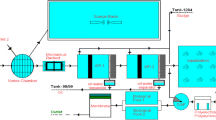Abstract
Experiments were carried out to study the biodegradability of pollutants from cooking fumes by active sludge domestication. The result indicated that temperature was the most important factor affecting biodegradation, and under the optimum conditions, the concentration of the pollutants from cooking fumes decreased from 56.9 to 0.78 mg/L in 28 h, the specific degradation rate reached 0.15 mg (oil)/mg (biomass) and the specific degradation speed approached 0.13 mg (oil)/h/mg (biomass) when the concentration of the pollutants was higher than 352 mg/L. The dominant strains consisted of bacteria, filiform fungi and yeast fungi, and yeast fungi were identified as Rhodosporidium toruloides.






Similar content being viewed by others
References
Anon. (1994a) Food industry or restaurant lipid wastewater waste-disposal using lipophilic yeast-e.g. Candida intermedia, Candida schatavii, Candida visuvanathii, Candida fluvatilis, Candida pseudolambica or Candida hellenica. Japanese Patent JP06062837 (Derwent Biotechnology Abstracts 13:94–07187)
Anon. (1994b) Vegetable oil and fat lipid degradation in waste-water—using Pseudomonas sp. and Acinetobacter sp. Japanese Patent JP 06153922 (Derwent Biotechnology Abstracts 13:94–11340)
Chen Y, Li Y, Zhao L (2002) Factors influencing biodegradation of kerosene. Chin J Appl Environ Biol 8(2):184–189
Chigusa K, Hasegawa T, Yamamoto N, Watanabe Y (1996) Treatment of wastewater from oil manufacturing plant by yeasts. Water Sci Technol 34(11):51–58. doi:10.1016/S0273-1223(96)00820-7
Koh J-S, Kodama T, Minoda Y (1983) Screening of yeasts and cultural conditions for cell production from palm oil. Agric Biol Chem 47(6):1207–1212
Kulowiec JJ (1979) Techniques for removing oil and grease from industrial wastewater. Pollut Eng 11(2):49–52
Liu Y (1999) Determining and analysis of organic pollutants from cooking fume in kitchen. Chin Environ Sci Technol 15(5):47–51
Ratledge C (1992) Microbial oxidations of fatty alcohols and fatty acids: biodegradation and biotransformations of oils and fats. J Chem Technol Biotechnol 55:399–400
Shirai K, Tanaka H, Nishijima M, Kanai S (1998) Screening of microorganisms in bioremediation of oiled shoreline. Mizu Kankyo Gakkaishi 21:376–382. doi:10.2965/jswe.21.376
Siegmann K, Sattler K (1996) Aerosol from hot cooking oil, a possible health hazard. J Aerosol Sci 27(Suppl):S493–S494. doi:10.1016/0021-8502(96)00319-9
Su S, Jiang W, Yang Z (2000) Advance on toxicity and disposal measures of cooking oil fume discharged from the restaurant. Chin Tech Equip Environ Pollut Control 1(3):77–81
Sun PS, Huang B, Huang RH (2002) Special bacteria and their function for biopurifying waste gas. China Environ Sci 22(1):28–31
Tano-Debrah K, Fukuyama S, Otonari N, Taniguchi F, Ogura M (1999) An inoculum for the aerobic treatment of wastewater with high concentrations of fats and oils. Bioresour Technol 69:133–139. doi:10.1016/S0960-8524(98)00181-3
Wakelin NG, Forster CF (1997) An investigation into microbial removal of fats, oils, and greases. Bioresour Technol 59:37–43. doi:10.1016/S0960-8524(96)00134-4
Zhang XR (2001) Influences of kitchen lampblack on human health and its protection design. J Safety Environ 1(3):41–43
Acknowledgement
We appreciate the financial support of the Program to Sponsor Teams for Innovation in the Construction of Talent Highlands in Guangxi Institutions of Higher Learning (GuiJiaoRen [2007]71).
Author information
Authors and Affiliations
Corresponding author
Rights and permissions
About this article
Cite this article
Liao, L., Liu, Ht. & Zhang, Bl. Biodegradability of Pollutants from Cooking Fumes. Bull Environ Contam Toxicol 82, 428–434 (2009). https://doi.org/10.1007/s00128-008-9595-2
Received:
Accepted:
Published:
Issue Date:
DOI: https://doi.org/10.1007/s00128-008-9595-2




